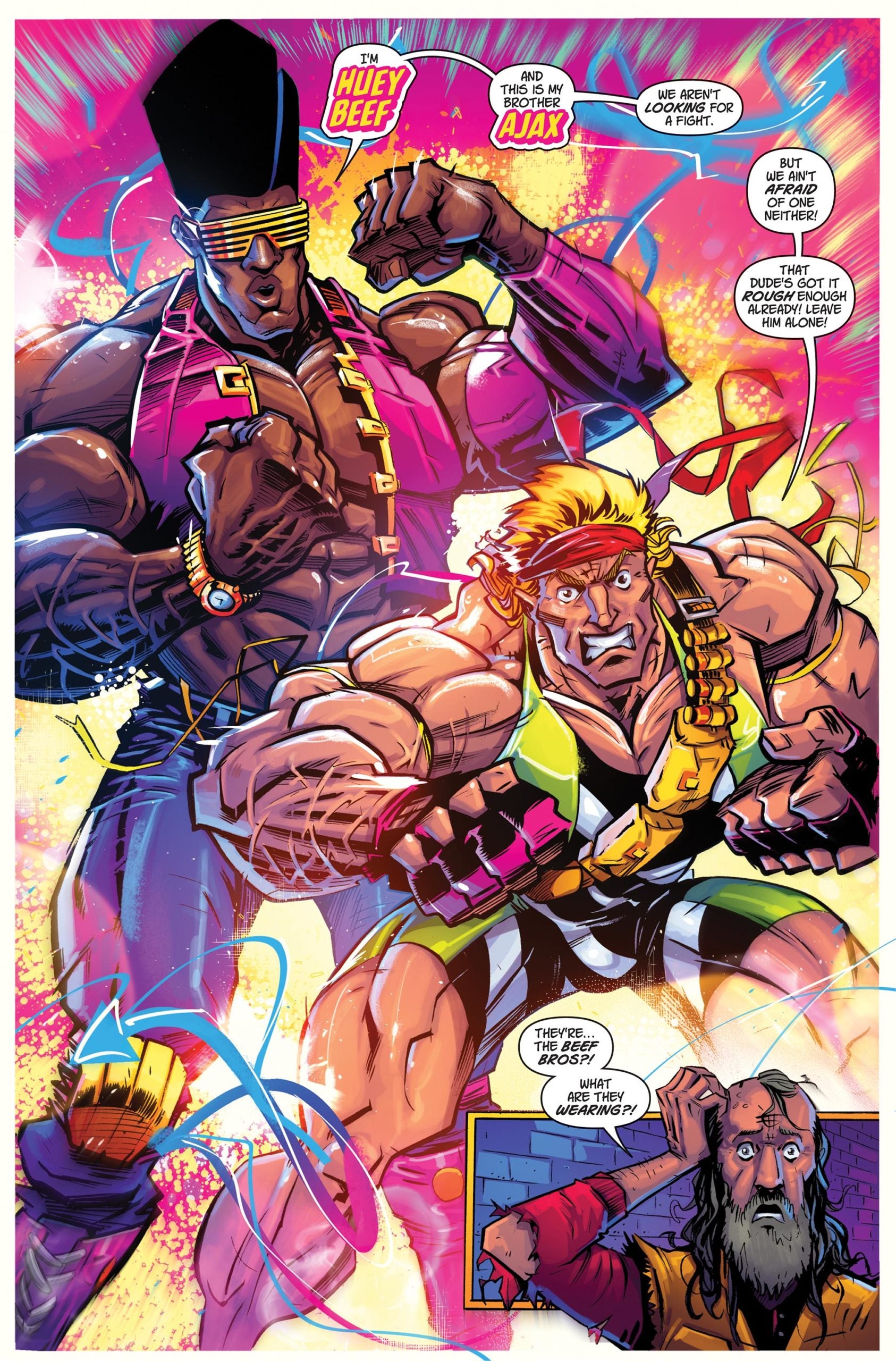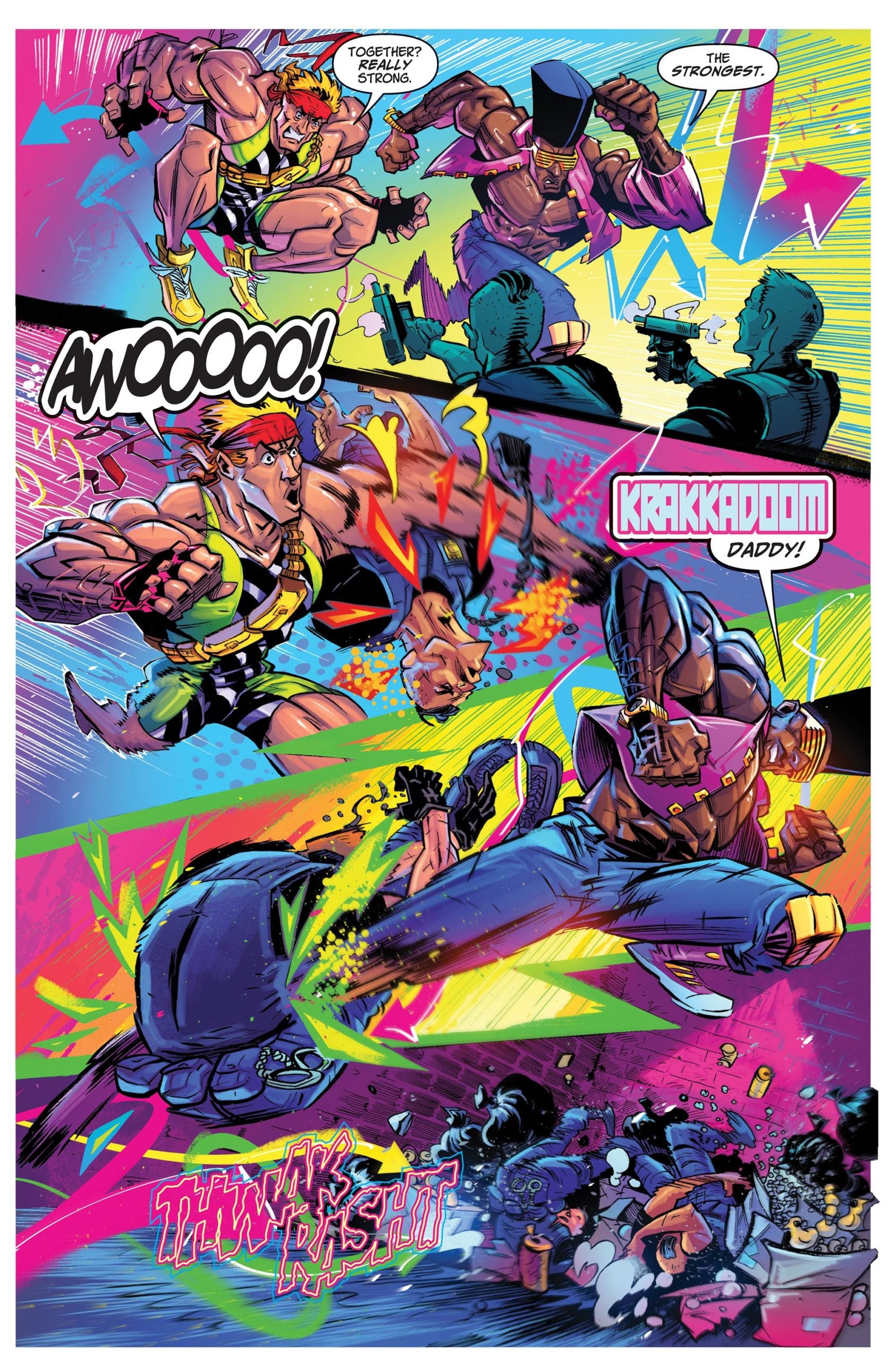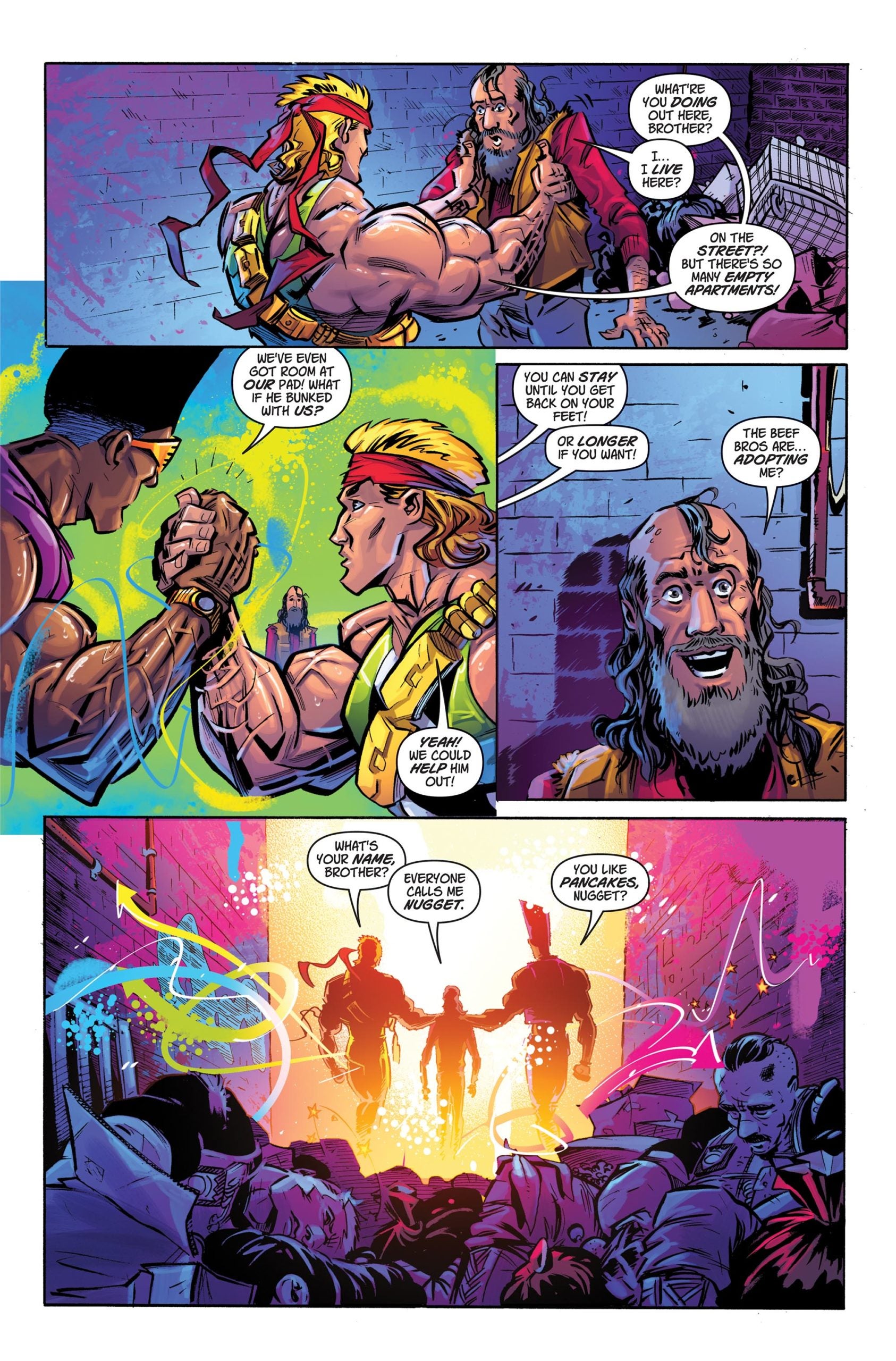With a handful of exceptions, superheroes are a conservative bunch. If they’re not violent vigilantes brawling to preserve the capitalist world order, like rich playboy turned hard-on-crime sadist Batman, they’re working as elite, Avengers-style teams either at the explicit or top-secret behest of a national and/or international government. These good guys beat up the so-called bad guys, to be sure, but usually this work is in the service of maintaining the status quo: The rebel army is “pacified,” the money is returned to the bank, the anarchist mad bomber is dragged from his cabin and hauled off to prison. Which is why writer Aubrey Sitterson and artist Tyrell Cannon took to Kickstarter to co-create the BEEF BROS — the capitalization is deliberate — a pair of well-meaning muscleheads whose own commonsensical “mass analysis” always lands them on the side of the masses against the classes.
This isn’t to say that various comic series haven’t analyzed the foibles of these more conventional kinds of heroes. From Watchmen and The Dark Knight Returns in the mid-1980s to The Boys and Jupiter’s Legacy in the mid-2000s and early 2010s, creators have been unafraid to depict the darkness lurking around the edges of the superheroic landscape. But these are gritty tales, fronted by gritty characters, and the sense of unease and even helplessness to bring about change is palpable. In most cases, their hapless efforts to alter the status quo end in tragedy, and any anti-heroes lucky enough to survive the carnage wander off into the distance after experiencing their own kind of “Forget it, Jake, it’s Chinatown” epiphanies.
Not so with BEEF BROS. Sitterson is a master of the colorful, minimalist “big fight” genre. His recent series No One Left to Fight, co-created with artist Fico Ossio, offers a meditative take on the sort of “fight progression” story popularized by manga like Dragon Ball — a melancholy epilogue to these great battles already fought. But even there, as in his earlier Street Fighter x G.I. JOE, few words are wasted in a tightly-plotted story that seems to fly by. Sitterson is drawing from a different well, both generally speaking and in terms of BEEF BROS inspiration.
“When it comes to political comics, I don’t think you can get much better than Howard Chaykin’s American FLAGG!,” he tells me. “It predates both Watchmen and Dark Knight Returns by a few years, and in my opinion, it’s even more influential, but in a secret kind of way due to falling out of print for so many years.”
American FLAGG!, for readers unfamiliar with Chaykin’s greatest work, was an early 1980s series that straddled both past and present. Chaykin wrote and illustrated the first 12 issues, which tell a unique story that wasn’t quite wacky space opera or full-on dystopia: Reuben Flagg, a Jewish-American actor rendered obsolete by CGI technology, becomes a space cop in the employ of the huge Plex corporation that now rules the earth’s reinforced “Plexmalls” from its capital on Mars. Flagg “wakes up” and turns on Plex, gets help from a talking cat among other oddball allies and the lush illustrations recall nothing so much as Silver Age, space operatic Gil Kane-style artwork updated for the age of punk rock and new wave. It was an awfully fun story about awful times, in other words.
That sense of spirited fun even in the face of mounting hypocrisy and injustice is something Sitterson considers essential to the work he and Cannon are doing. “I’m also a huge Bloom County and Outland fan,” he says. “Reading those strips as a kid, I didn’t have the necessary context to understand many of the references, but they were so stripped-down, effective and funny that I was able to get the gist anyway. Berkeley Breathed’s surreal bemusement at the absurdity of U.S. political and cultural life, combined with his simmering rage toward hypocrisy and exploitive hierarchies of all stripes was profoundly influential stuff for me.”

The BEEF BROS don’t simmer with rage, though. Huey and Ajax Beef, styled like bodybuilders from the 2000s as envisioned from the vantage point of 1980, act on their instincts. And these instincts, as revealed in the pages of story already published on their Kickstarter page, are to help the helpless in their struggles against the powerful. Two sadistic cops harassing a homeless person receive a rapid-fire beating from the BROS, who deflect bullets with their pectoral muscles, and then invite “Nugget,” the man they rescued, to stay with them. Not because it’s the right thing to do, but because, in their simple calculus, it’s the only thing to do. Nugget lacked a home, so they opened theirs to him.
The simplicity of this story, told through bulging biceps, colorful outfits and a fast-paced fistfight, is the key to the BEEF BROS appeal. “It’s not enough to just have a good comic book,” Sitterson says. “You need a project that people hear about, instantly understand and yearn to see birthed into the world. Once I saw Tyrell’s designs for Huey and Ajax Beef, I knew BEEF BROS would be huge on Kickstarter [and it has been, to the tune of 1,220 backers already pledging to support the project].”
Indeed, the BEEF BROS character designs are throwback gold. In the critical imagination, muscular bodies can mean all sorts of things — violence, oppression, power wielded over others — but here, as drawn by Cannon, they mean just one thing: Buff folks are strong enough to lend a helping hand. “I always look to Renaissance art, especially sculptures by Michelangelo, for inspiration when drawing the male form,” Cannon says. “Gian Lorenzo Bernini also, as he brings a lot of romance and movement to the figures. Every comic artist should also be studying Auguste Rodin sculptures to get that big heavy feeling in the figure. For comics, I love 1990s stuff like Stephen Platt’s extreme style on the two issues of Prophet he finished, Jae Lee’s Namor and X-Factor stuff, Dale Keown’s PITT, and of course, Jim Lee’s X-Men for those big bold group shots.”

Obviously, with a concept like this, much hinges not just on the muscles but the fistfights. If self-help and cooperation is at the core of the BEEF BROS ethos, fistfights are where the bros must excel. “Good fistfights are really hard to pull off in comics. But that’s my current mission. I’ve been studying a lot of Tradd Moore,” Cannon explains. “The way he depicts action and figures in motion in Luther Strode is a quantum leap in the medium. I’ve looked at a lot of Jason Pearson’s Body Bags lately too, with their high contrast and stylized impacts to sell the action. In manga, Fist of the North Star is permanently imprinted into my brain. The intensity to every strike and the beats within action scenes really sell the drama. Hideo Yamamoto’s Ichi The Killer has insane action scenes that bring speed and a weird intimacy to the fights. Masamune Shirow’s Appleseed is a paramount example of how comics can show action in completely chaotic ways, throwing out conventions of storytelling, but still work extremely well.”
Sitterson is himself a fistfight aficionado, not so much for the gory action as for what a well-timed punch can add to the action. “You know all my favorite fight manga/anime: Dragon Ball, Jojo’s Bizarre Adventure, Baki, Kengan Ashura, etc.,” Sitterson says. “But when it comes to domestic comics, there aren’t many better than Ryan Ottley. Watching him grow and stretch on Invincible was awe-inspiring. To have some of the best fight scenes in comics history all take place in a single book is something extremely rare. There’s a weight and a visceral feel to the way he depicts combat. Every single blow means something.”
Invincible, which Ottley co-created with The Walking Dead writer Robert Kirkman, explored family dynamics in part through super-powered fists being driven through guts, ripping out entrails and spilling blood all across the galaxy. It was a story about how people are complicated, how life is complicated and yet in spite of all those complications, things will ultimately work themselves out, for better or worse.

The BEEF BROS, as envisioned by Sitterson and Cannon, are most assuredly not complicated people. They are, rather, big strong blunt men facing a complicated world full of powerful and duplicitous forces — a throwback not so much to Batman or Superman, two costumed agents of the establishment, but to a much earlier hero, E.C. Segar’s Popeye, star of his Thimble Theater comic strips. Popeye, the great idol of both my father’s early childhood and later my own, was a volatile and seemingly anarchic force, as invincible as Superman yet moved only to act by his own caprices: He was “disgustipated” whenever someone threatened to harm those he saw as powerless, the “wimen and infinks” (though many of the hard-hitting women in the strip, like the formidable female pirate The Sea Hag, were anything but powerless).

Popeye had no overarching mission, drifting from one of his friends’ hare-brained schemes to another, but he’d always right the scales of justice when a bully or monster appeared — and then he’d right the scales again by stepping in to save the bad guy whenever one of his shrewder friends, like feckless intellectual J. Wellington Wimpy or his love interest Olive Oyl’s cunning brother Castor, attempted to kill or disable them. “I ain’t really got nothin’ against ya ’ceptin’ ya broke me neck… Ya want to shake hands an’ be frens?” he asked the giant caveman Toar, whom he had finished beating to a pulp at the end of a memorable 1935 storyline entitled “The Pool of Youth.” After Toar agreed to be friends and returned home with Popeye, Olive Oyl asked Popeye what he intended to do with the uncivilized brute. Not missing a beat, and foreshadowing the BEEF BROS of 2020, he told Olive, “I yam gon’er dress him up,” thereafter putting Toar in a fancy shirt and tie for no other reason other than it seemed to the simple-minded sailor like the proper course of action.
The BEEF BROS are cut from this same cloth. They aren’t out there thrashing would-be Jokers to save the world from a descent into disorder or beating up a bunch of terrorists seeking to liberate their country from the benevolent clutches of their world’s version of the United Nations. No, they’re just walking the streets, “showing off their big, muscle-bound, vascular, bulging bodies” in Sitterson’s words, dispensing that instinctive brand of BEEF BROS justice — not because it’s the right thing to do, but because it’s the only thing to do.

